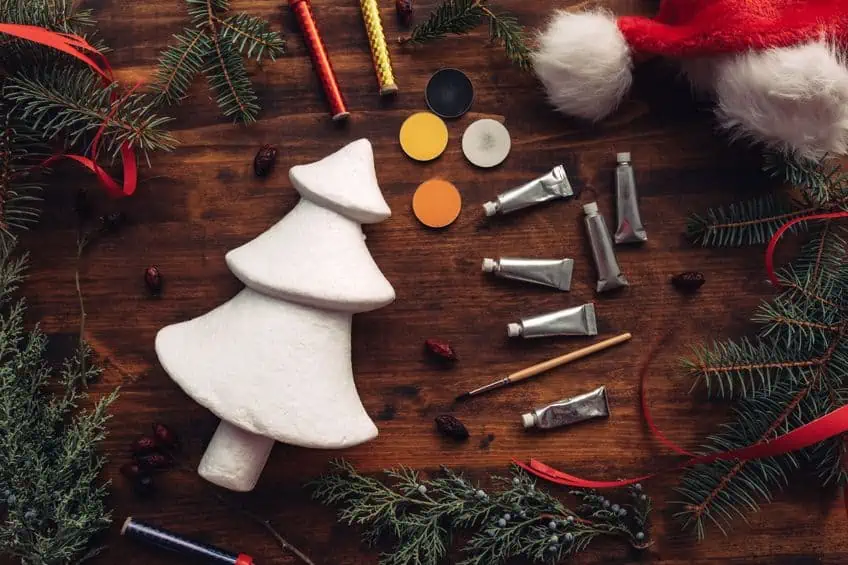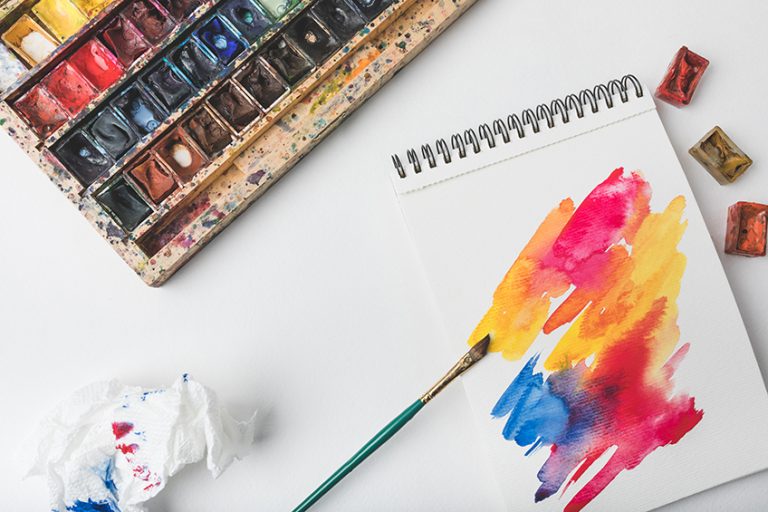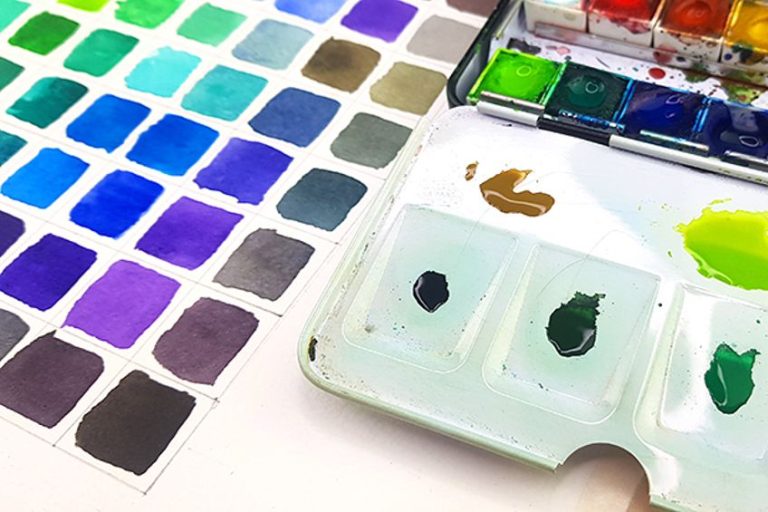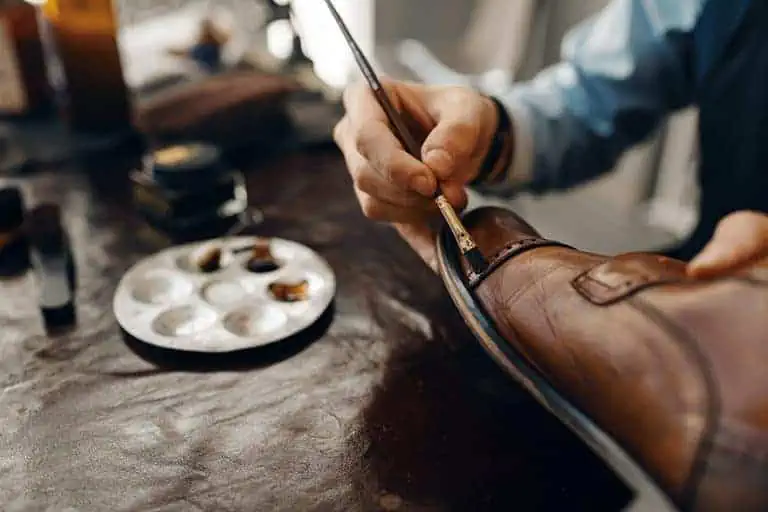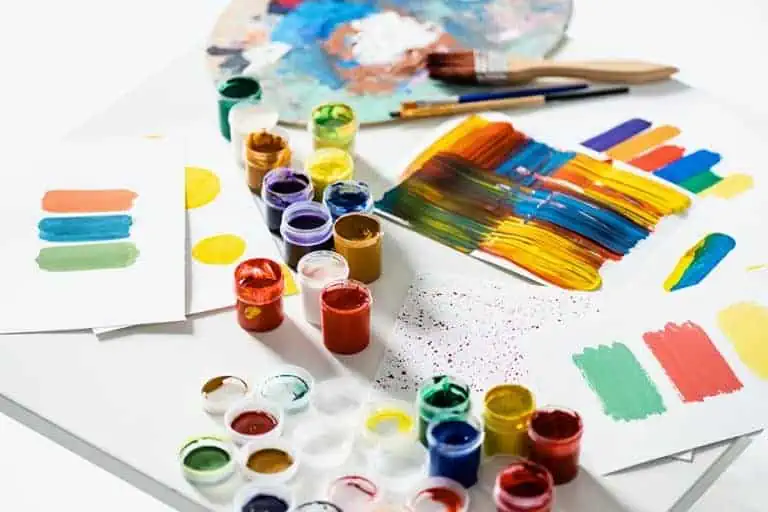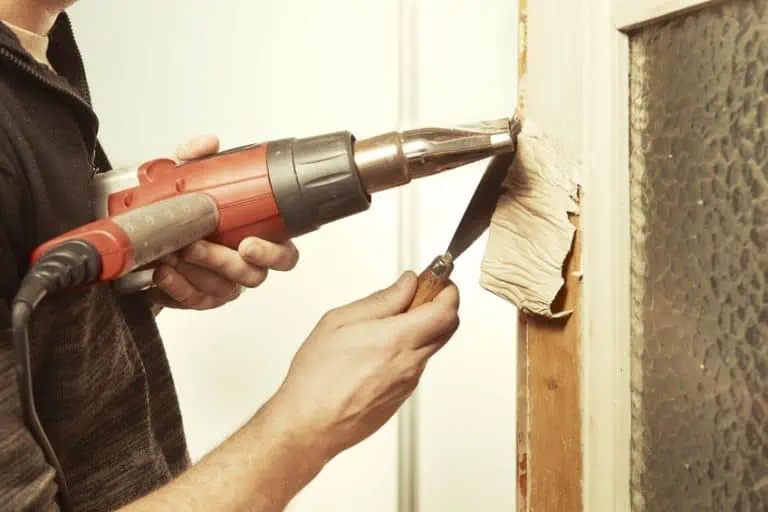How to Paint Styrofoam – The Best Method for Styro Painting
This post may contain affiliate links. We may earn a small commission from purchases made through them, at no additional cost to you.
Using Styrofoam for craft ideas may have come to you at some stage whilst thinking about home projects, and this begs the question, can you paint Styrofoam? The answer is yes, painting Styrofoam is wonderful for school projects, crafts for kids, and stunning seasonal decor. That said, Styro painting requires a little know-how as it is an unusual surface to work on. You may have already tried out a few different Styrofoam paints or methods but you still have a lot to learn to create your perfect project. The following article will help to get you familiar with the material, teach you how to paint Styrofoam, and inspire you to try those exciting ideas!
Table of Contents
- 1 What Kinds of Paint Are Best for Painting Styrofoam?
- 2 What to Remember When Painting Styrofoam
- 3 What Is Styrofoam?
- 4 How to Paint Styrofoam: A Brief Tutorial
- 5 Useful Tips for Styrofoam Painting
- 6 Frequently Asked Questions
What Kinds of Paint Are Best for Painting Styrofoam?
The rule of thumb when it comes to Styro painting is to avoid media that contain solvents. There are, however, some good Styrofoam paints that offer excellent results. You will find all these options in your local craft store along with specific Styro paint for this type of material. Whichever paint you choose to go with, be sure to read the label, it should be tempera or acrylic paint, otherwise, it must state that it can be safely used on surfaces such as polystyrene and Styrofoam.
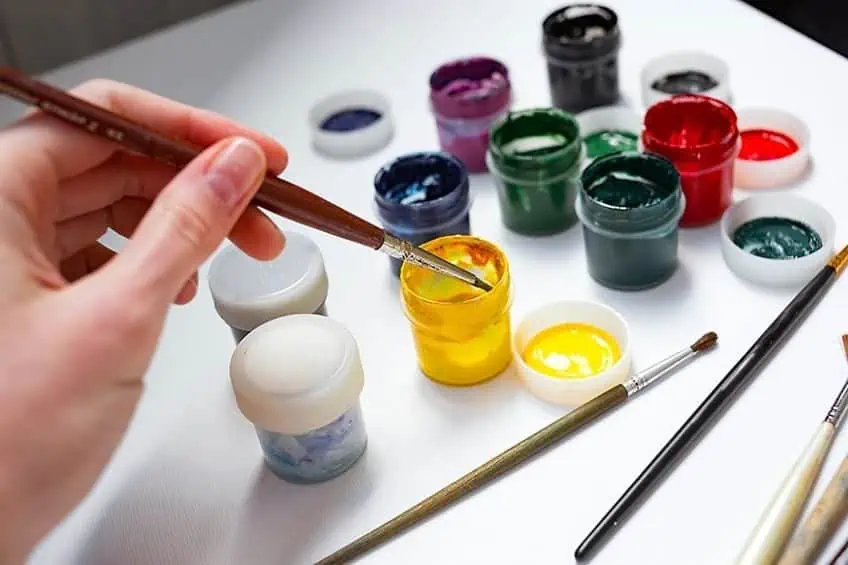
Acrylic Paint
Your best and most widely available option for painting Styrofoam is acrylic paint, this is because it is water-based and contains no solvents or chemical agents that will melt the Styrofoam. Acrylic paint on Styrofoam is simple to begin, a priming medium is not necessary and the paint adheres effectively, although a few coats may be necessary to cover the surface. If your project is more short-term, for example, Christmas tree decorations, acrylics are perfect.
If you are hoping for a longer-lasting project, these paints can degrade the Styrofoam and so specially designed Styro paint would be a better option.
Best Acrylic Paint Set: MAGICFLY Bulk Acrylic Paint Set
This acrylic paint set by Magicfly has 14 brilliant, non-fade paints, including metallics. It is safe, easy to mix, simply applied, and quick-drying with a non-glossy surface finish. These paints are suited to most surfaces, including Styro painting as they offer good surface covering ability.
- The acrylic set contains 14 vibrant colors in large volume tubes
- The paint is thick, creamy, easy to blend, and dries quickly
- Can be applied to a range of different surfaces like styro
PROS
- Affordable
- Safe to use
- Fast-drying ability
- High in quality
- Vibrant, non-fade colors
CONS
- Can dry too fast, this limits your painting time
- You must shake before use
Latex Paint
Latex paint comes in a good range of colors and is usually purchased in fairly large tins which, if properly stored, last well for up to two years. Application is much like acrylic paint and cleaning is very simple with water and a little soap. Latex paint is also a good option when it comes to how to paint Styrofoam. This water-soluble paint is made using acrylic resin product and is often used for interior painting.

These paints are more suitable for larger projects than smaller ones as they do not dry very quickly, although you do require fewer layers to cover the surface. Latex paint is a suitable option for Styro painting, bear in mind however that it tends to not last as long as acrylics and should be kept at stable temperatures where possible to avoid the paint cracking.
Tempera Paint
Tempera paint is also a very good medium when it comes to how to paint Styrofoam. These paints come in a range of various finishes and are widely available. They are water-soluble, therefore your project should ideally not come into contact with water.
Tempera paint has a rather limited color range and it does not mix as easily as acrylics do.
Best Tempera Paint Set: COLORATIONS Simply Washable Tempera Paints
This tempera paint by Colorations is a good Styro paint option to consider as it works on many different surfaces. The best thing about Colorations paint is that you can craft with the kids and not have to worry about ruined clothes because it is completely washable. This is a set of 6 vibrant colors that are quick drying with a matte result.
- Includes red, orange, yellow, green, blue, and white shades
- The paint has a smooth, rich consistency that dries matte
- Washes off of skin, fabric, and surfaces with soap and water
PROS
- Fast –drying
- Safe to use
- Value for money
- Easy to wash
- Free of any allergens
CONS
- May stain harder work surfaces
- May tend to crack depending on the surface
- Not an artist level product
Spray Paint
You may also be wondering at this point, can you spray paint Styrofoam? Indeed, this is another way of how to paint Styrofoam successfully, however, this must be a specific Styro paint spray. This is because usual spray paint is made up of solvents that will corrode and eat away the polystyrene. Always make sure that the label specifies that the paint is safe for use on foam materials when asking, can you paint on Styrofoam.
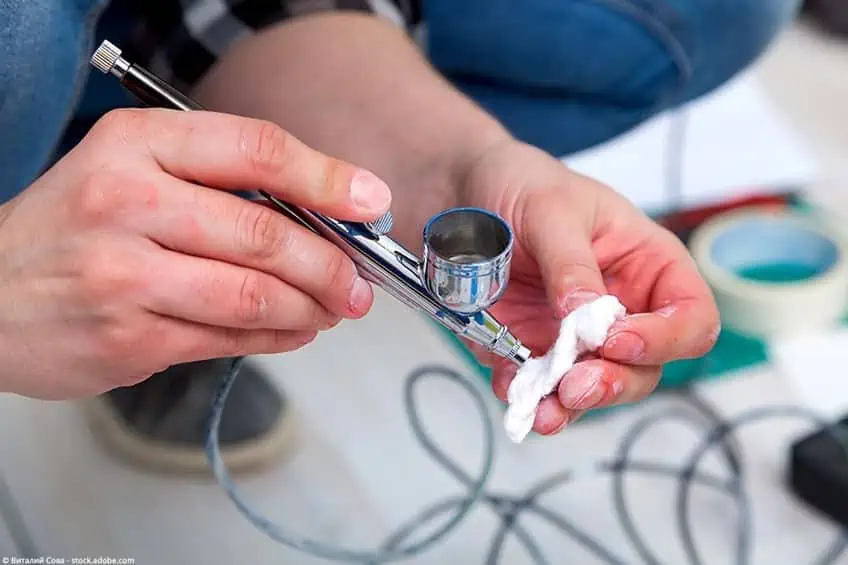
Best Spray Paint on Styrofoam: KRYLON Short Cuts Aerosol Paint
Krylon is definitely the most renowned and popular spray paint brand. They are known for their versatility, quality, and vibrancy. This particular spray paint is fast drying and produces a very high-gloss finish. Not only can you use this spray paint on styrofoam, but it is also suitable for other materials including metal, wood, wicker, and plastic. Although this spray paint is acid-free and safe to use, prolonged exposure to the fumes can damage your eyes and lungs, so be sure to use it in well-ventilated areas.
- This high-quality spray paint dries quickly to a glossy finish
- Suitable for wood, metal, wicker, Styrofoam, and more
- The paint is acid-free and archival safe for use
PROS
- Hard-wearing finish
- A good surface covering ability
- Dries quickly
- Large color range
- Easy to apply
CONS
- Available only in smaller cans
- More expensive
- Less vibrant chrome colors
In the table below, we have summarized the pros and cons of the different types of styro paint available.
| Acrylic Paint | Tempera Paint | Spray Paint | |
| Availability | Widely available in a large color palette | Found in most craft stores with a smaller color range | Most craft stores, only in specific brands |
| Application | Easy to brush on | Brush on with a paintbrush | Spray can |
| Adherence
| Brilliant and water-resistant once dry | Brilliant but is not water-resistant | Brilliant |
| Drying | 20-30 minutes | 5-10 minutes | 15 minutes |
| Durability | Can corrode polystyrene in time | Contact with water does damage the paint | Lasts well |
What to Remember When Painting Styrofoam
Styrofoam, as a “blank canvas,” is a very different material from what you may typically be used to. It is wise to get to know what you are working with before diving straight in and using unsuitable paint. There are certain methods and products that can help you navigate any obstacles and understand the best way to successfully create your desired project. The following includes some useful information and guidelines for how to paint Styrofoam.
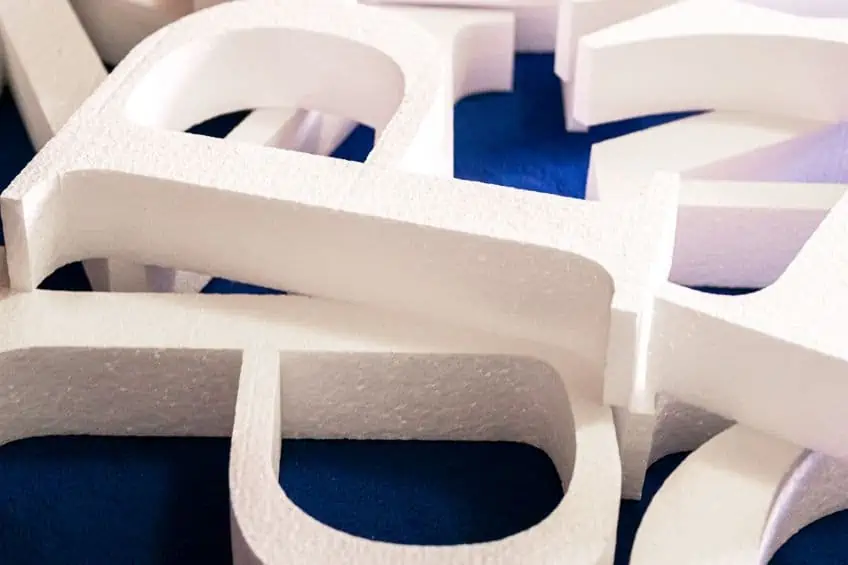
What Is Styrofoam?
Styrofoam is a fairly fragile, very light product that is often used for protecting packaged items and for thermal insulation qualities. Styrofoam is actually just a brand name, with the real full name being expanded polystyrene or foam. In this article, we will either use the term polystyrene or Styrofoam.
This plastic has a petroleum base which is why it may be difficult to paint as some paints do not adhere properly or melt the polystyrene.
Challenges with Styrofoam: Can You Paint Styrofoam?
Due to the complex makeup of this material, any paint products that include solvents should be avoided as they will corrode and melt the polystyrene. Examples of these solvents would be acetone, benzene, toluene, and tetrahydrofuran (or THF). Since Styrofoam is very spongy, with an uneven surface, it can be difficult to get good surface coverage and a clean finish. As a result, a few coats of paint may be required with the help of specific brushes and certain technical tips that we have discussed below.

Use the Correct Paintbrushes
As polystyrene is spongy in texture, paint does not give great coverage simply by painting the surface as you normally would. Using the correct paintbrush and sort of scrubbing method you are more likely to get the paint into each little area of the potted Styrofoam.
Brushes that you can use for this technique are the following:
- Foam Brushes: These are a popular choice for painting odd shapes and surfaces as they get into crevices and cover the surface well, there are a variety of sizes to choose from.
- General Paintbrush: This brush will give a smooth result once a few layers have been applied.
- Stencil Brushes: This brush has shorter bristles for getting into porous areas.
- Roller Brushes: These are foam brushes, excellent for painting a larger area.
Apply Several Layers
For a smooth, even result, it is advised to do more than one coat of paint. As with most painting methods, ensure that each coat is dry before you apply the next one. You can do as many coats as is necessary for your desired effect.
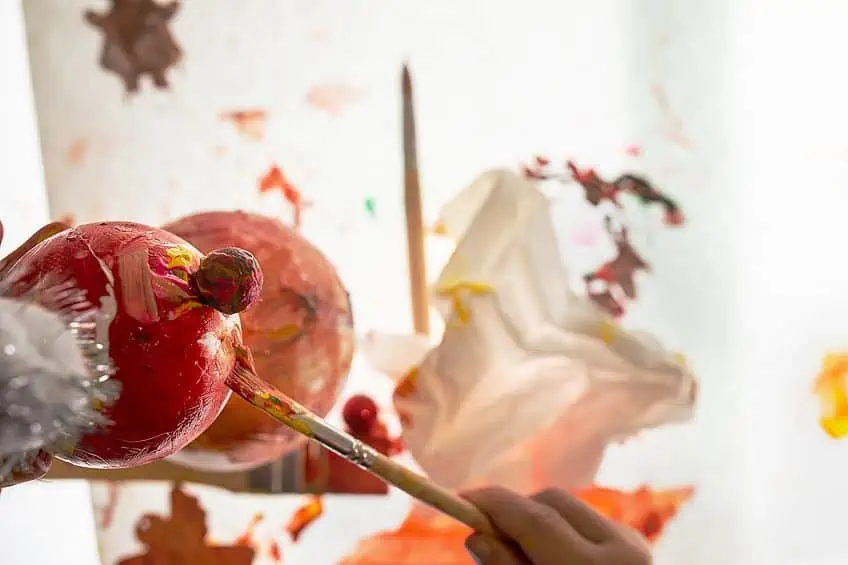
Use a Sealant
Using a sealer like Mod Podge or Plaster of Paris for styrofoam will give you a smoother, more even layer on the Styrofoam on which to paint. If the sealant is applied thoroughly and correctly, it can also be used as a protective layer should you choose to use other paints containing solvents.
This way, the polystyrene material will not be corroded.
How to Seal Styrofoam Before Painting
Should you decide to go the route of using paint that is corrosive to polystyrene, the most important thing to do is to prime and seal the surface. Use a good finishing product suited to foams, such as Smooth Finish, this will help to give you an even surface and prevent the paint from cracking. Here are the steps on how to seal Styrofoam.
- Start by using a paintbrush or utensil such as a palette knife to spread a thin, even coat of Smooth Finish onto the Styrofoam, making sure to cover the edges, corners, and holes that you may find.
- Allow this coating to dry for one to two hours and then using sandpaper, take off any uneven areas. This product is very smooth and the application is painless, so you should not have to sand very much.
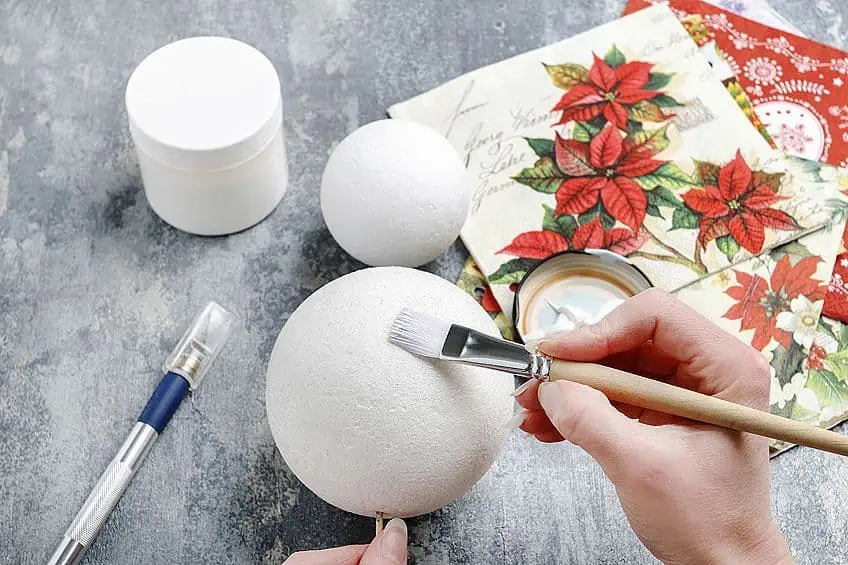
- Go onto your next layer by repeating the first step.
- When these coats are dry and sanded flat, your Styrofoam will be sealed and protected, ready for you to use any paint of your choice without worry.
How to Seal Styrofoam After Painting
When your project is painted and has dried properly, you might consider sealing the surface with a sealer or varnish for added protection. Whichever option you choose depends on the finish you want to achieve, as well as where your project will be positioned, the purpose, and the intended life span.
In terms of sealing options, there are a few different routes available, including spray paint coating, decoupage product, and polyurethane sealer.
You can choose the type of finish you want, some available options being, matte, glossy, lacquered, and flat. Should your project be located outside, or in a sunny spot, there is a UV-resistant sealer that will protect the paint from fading from the elements.
How to Paint Styrofoam: A Brief Tutorial
There are a number of imaginative and clever ways to craft with Styrofoam. It can be used for special occasions in decor, such as birthdays, weddings, and new years parties, it is a wonderful material for school projects, stage props, and even fancy dress. Many of these objects have shapes that can prove difficult to paint. Knowing how to paint Styrofoam ball shapes is one thing, but it can get even trickier. The following will help you step by step to get around those cumbersome shapes.

Step 1: Set Up Your Materials
- Butchers paper or newspaper to protect your work surface and prevent spills.
- Your Styrofoam project, for example, plain polystyrene letters for a bedroom door decoration.
- A plate or tray to put paint on and dip brushes into.
- A Latex primer to even out the surface area for painting.
- Latex paints in the colors you require.
- Foam brushes are appropriate for the size and shape of your project, in this case, we are using foam letters as an example.
Step 2: Prepare Your Working Space
Spread paper over your work area and secure it with tape so that it does not move. You might want to put some paper on the floor as well just in case. Latex paint can easily be cleaned but it just creates more work, whereas you could be enjoying working on your project.
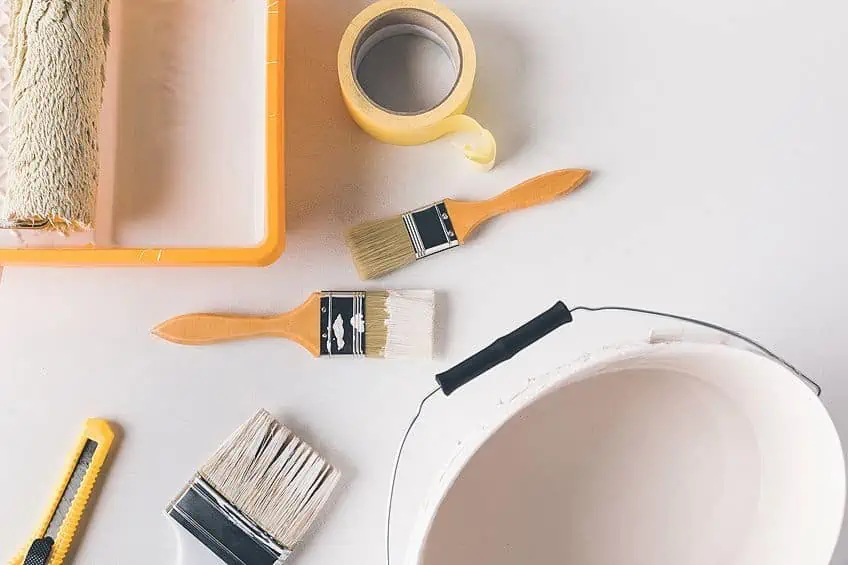
Step 3: Apply the Primer
You do not have to use a primer, however, it will make coverage of the foam surface much easier and create a smoother finish. To prime your polystyrene, work from one area into the next so that you are sure to get into all the crevices. In the case of Styrofoam letters, prime the edges first and allow that to dry, you can then move onto the front and back areas. Choose the best size brush to reach into the corners and difficult-to-reach angles.
A single layer of primer should be dry within 60 minutes, you can then apply a second coat if necessary.
Step 4: Painting with Color
Now, to really see things take shape. Make sure the primer is completely dry and then using foam brushes again, begin to paint the Styrofoam. Apply the same techniques here as the primer, color the sides to begin with, and allow to dry, then continue on to the front and back of the shape. Ensure an even application technique that will give you a smooth result. Allow 60 minutes of drying time and add a second coat of paint. You will need two or three paint applications to achieve optimal surface coverage.

Step 5: Seal or Varnish the Polystyrene
Once again, you do not have to seal your work, although it does add a protective layer and give a desirable finish to foam letters or any other projects. Make certain that the letter is properly dry and then using a clean foam brush paint a thin coating of sealer onto the surface. Alternatively, you can use a spray can of aerosol sealant in much the same way.
Drying times may differ depending on the type of sealant you have decided to use.
How to Paint Styrofoam Ball Shapes
Round balls and similar three-dimensional shapes can prove tricky to paint and avoid making a huge mess all over yourself and everything else. Something you can do, which will make things much easier, is to put a skewer or toothpick into the foam which you can then hold on to. Something else you can do is to cut toilet roll inners into shorter sections to act as little stands for your Styrofoam spheres to stand on. This will steady them and allow you to paint sections of the ball at a time. Allow these areas of paint to dry and then simply adjust the ball to color the other side.
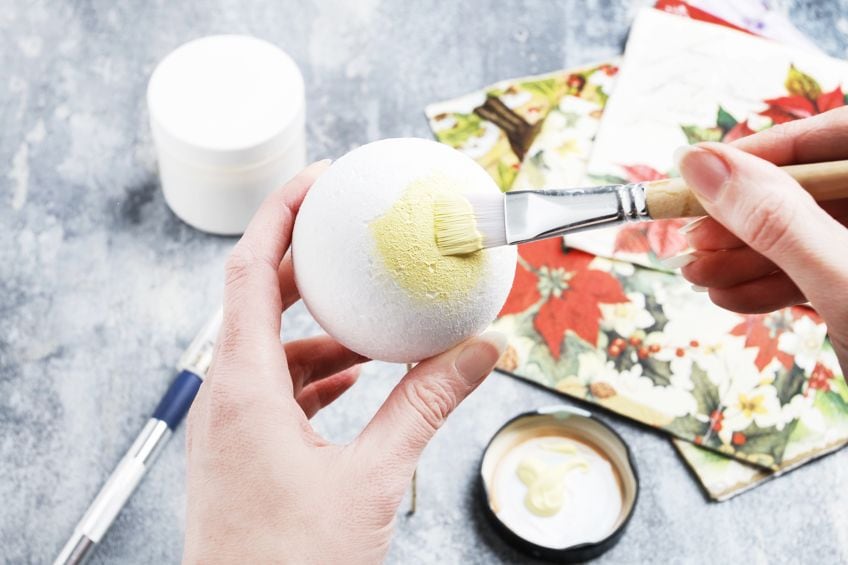
Can You Paint Styrofoam with a Paint Sprayer?
A paint sprayer is perfect for larger jobs where a lot of surface area needs to be covered, this might include things like stage backgrounds and large displays or models. Various sprayers are available, including paint spray guns and airbrush sprayers. Airbrushes are easy to use and you have a good amount of control over the application. They create good even paint layers, blend well, and are handy for work in finer areas. Using a spray gun will also provide a smooth finish and is particularly useful for covering large areas.
The following guidelines will help you to navigate using a spray gun to color Styrofoam projects.
Step 1: Set Up Your Materials in Your Workspace
- Newspaper to cover your work surface
- Old clothes or protective overalls
- Paints
- Thinners for paint
- Well aired work area
- Gloves, safety goggles, and respirator
- Cheesecloth for straining paint
- Air hose
- Tools for cleaning
- A spray gun and a holder
- Utensil for mixing
- Compressor
Step 2: Safety Preparation and Precautions
Whatever type of materials and paint you use for your craft projects, your health and safety should always be your top priority. Always read the instructions and label on the product, including the Material Safety Data Sheet where possible.
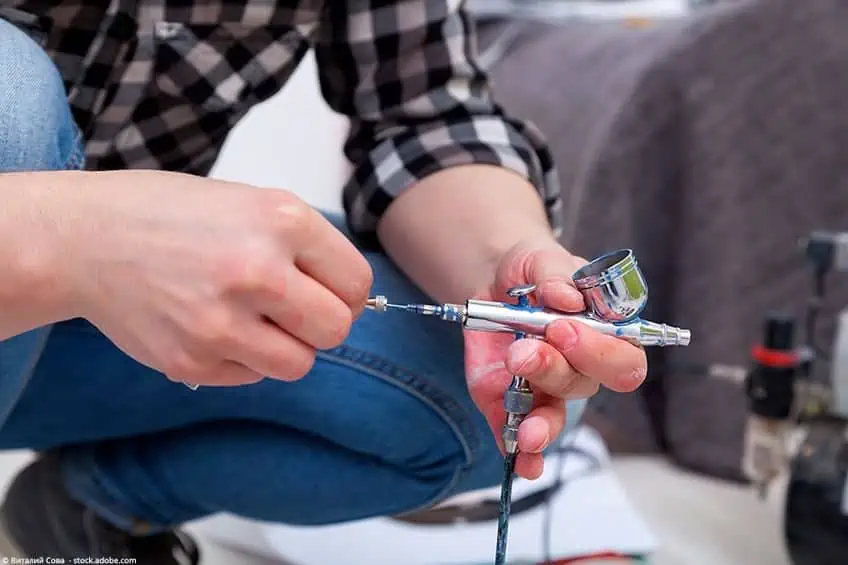
As noted above, goggles and a respirator are the necessary precautions to protect your respiratory organs and eyes from toxic paint fumes and excess paint residue. Gloves and overalls will help to protect your skin from paint splatter.
Step 3: Spray Gun Set-Up
Important parts of any spray gun are the fan nozzle, pressure nozzle, air cap, fluid nozzle, needle, and tip. For the purposes of this article, we are going to refer to the spray gun used as a gravity or cup gun. The reason for this is that there is a cup-like vessel at the top which contains the paint which gravity is then used to feed the gun with paint. As always, read the user instructions for the gun before using it.
Attach your spray gun to an air hose, this air hose must then connect to an air compressor.
Pressurized air, which we measure in pounds per square inch, is then set up in accordance with the instructions on the paint product. The measurement will likely be in the region of 40-80 pounds per square inch. Then adjust your fan nozzle to the size of your surface area. For a large area, the fan will be wider than a small area. Check the adjustment of your air pressure in accordance with the fan nozzle.
Step 4: Thin the Paint
Any paint used with a spray gun will need thinning. Although you can use any paint, it is wise to keep to latex or acrylic paint on Styrofoam. As these paints are water-based, water is used to thin the acrylic or latex paint. The paint needs to be the same viscosity as milk for this type of spray paint. To test the paint, dip in a mixing stick, when it is lifted, just three paint drops should fall, this will indicate the correct consistency. Should there be more drops, then your paint is over-thinned.
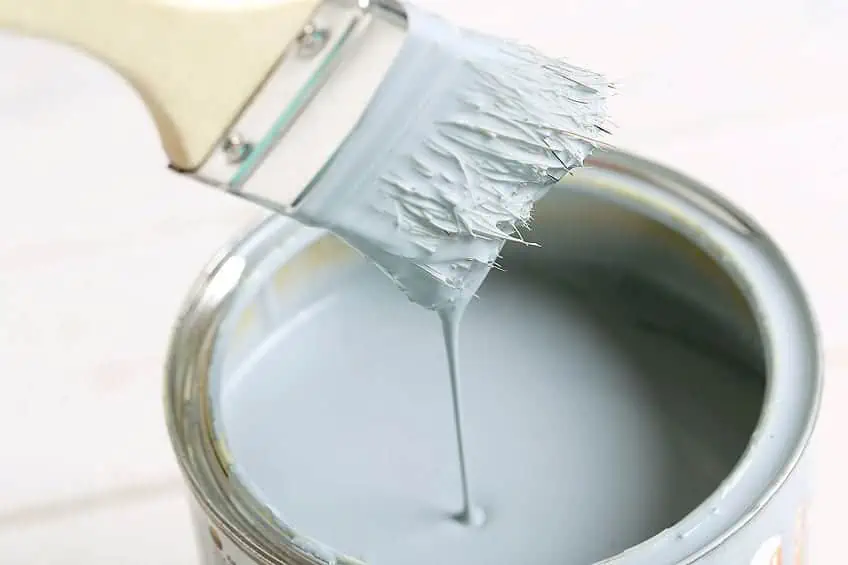
Step 5: Setting Up and Filling Your Spray Gun
Now that the paint is thinned down, it can be poured into the cup of your spray gun. Pour slowly so that the cup does not overflow and you do not put in so much paint that the gun becomes too heavy. When you do this step, use a piece of cheesecloth to strain the paint, you will be surprised by the number of dust particles and dry paint residue that can get into the paint. This debris can block your spray gun and is not something that you want to have to deal with. Then put the lid on the cup and make certain that it is secure.
Next in the setup process is to switch on the compressor, you can use a “quick connect”, which allows the air hose to quickly be connected or disconnected from the gun. Check your air pressure setting and make sure there are no possible air leaks from the hose or the gun.
Step 6: Test Before You Begin
To be on the safe side, you should always have a spare piece of polystyrene to test the spray paint before you start on your actual project. Should you find anything not quite right, you can easily make adjustments to either the gun or the paint for an even and uniform finish.

Step 7: Begin Spray Painting
Now that you are happy with the spray test the fun part can begin. For the best results, hold your spray gun at a 90-degree angle, about 5- 8 inches from the polystyrene. We recommend spraying from the top, working in a downwards direction from the left to the right-hand side. After every “plane”, release pressure on the trigger gently and add pressure again at the start of the next section or “plane.
This technique of spray painting does take some getting used to, keep going and with a little time and practice you will be a pro at getting the polished, even surface that you are looking for.
Useful Tips for Styrofoam Painting
Painting styro is not the most common practice, so you may need some additional tips and tricks to help the process run a little smoother. Here are our top suggestions to help you with your painting styrofoam journey.
- Should you wish to leave areas of your project unpainted, you can use masking tape to cover those sections.
- If you want to add to your project with mixed media articles and decorative pieces, rather avoid any metallic paint as the pigment will interfere with any adhesives or glues you may use.
- Tempera paints are the best for kids’ crafts and assignments as the paint dries quickly so that they can keep working on the project and avoid having to wait.
- Gently sand your polystyrene before painting to help paint adhere and give a nice even surface.
- Practice and experiment on Styrofoam offcuts when learning how to use a spray gun, this will prevent mistakes on your actual project.
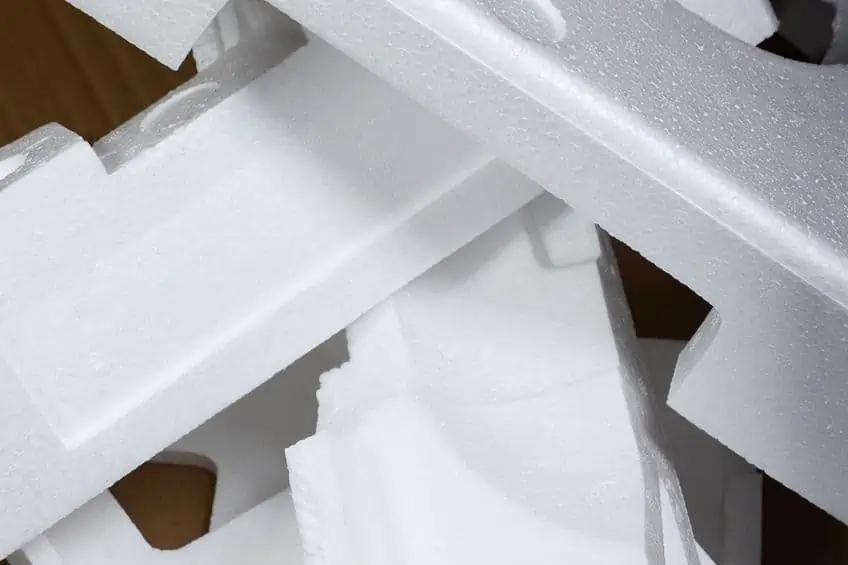
- Use thin coats to paint your polystyrene, this allows the paint to dry quicker and helps to prevent any cracking or flaking.
- When using a gun, try to spray the paint vertically downwards in sections, as well as along in horizontal lines, this will give good overall surface coverage.
- If there is any uncertainty as to whether paint you may have is safe to use on Styrofoam, do a small test on a spare piece of foam just to make sure, this will prevent wastage and extra work.
Styrofoam is a versatile craft material that is found in many home studios and school art rooms as it offers such a wide range of exciting and fun uses. There are definitely a few mistakes that can be made with Styrofoam, but with the correct knowledge of paints and techniques, it is straightforward and very rewarding. If you have never tried any Styrofoam painting and are here to find out if and how it can be done, we hope that you have come away informed and inspired to create your own stunning art projects.
Frequently Asked Questions
Will Sharpies Work on Polystyrene?
Oil-based Sharpies are great for intricate decorative work on polystyrene, imagine stunning festive Styrofoam baubles! You can jump right in with Sharpies, no priming, drying, or sealant is required.
What Kind of Paint Can I Use on Styrofoam?
The best paints to use on Styrofoam are either acrylic or water-based paints as you get the best coverage on your project. They are also inexpensive and easy to apply.
Can I Dye Styrofoam Balls?
If you do not want to paint your Styrofoam, there is a quick and easy method to dye foam spheres. Simply put white glue into an old saucer or paint tray. Add a few drops of food coloring and mix to incorporate. Put a toothpick or skewer into the ball to use like you would a handle. Roll the ball in the glue to cover, then stick the skewered ball into some foam so that it can remain upright to dry. The glue will dry clear leaving you with a colored Styrofoam ball.
In 2005, Charlene completed her wellness degrees in therapeutic aromatherapy and reflexology at the International School of Reflexology and Meridian Therapy. She worked for a company offering corporate wellness programs for several years before opening her own therapy practice. In 2015, she was asked by a digital marketer friend to join her company as a content creator, and it was here that she discovered her enthusiasm for writing. Since entering the world of content creation, she has gained a lot of experience over the years writing about various topics such as beauty, health, wellness, travel, crafting, and much more. Due to various circumstances, she had to give up her therapy practice and now works as a freelance writer. Since she is a very creative person and as a balance to writing likes to be active in various areas of art and crafts, the activity at acrylgiessen.com is perfect for her to contribute their knowledge and experience in various creative topics.
Learn more about Charlene Lewis and about us.
